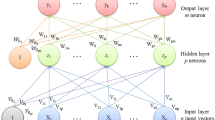Abstract
Back-propagation neural network (BPN) is sufficiently suitable for forecasting of Chaotic data time series by two approaches i.e., parametric forecasting and time-series forecasting. However, conformation of its optimum architecture for a specific case is pre-requisite. Total rainfall-runoff (R–R) from Basantpur station over Mahanadi river basin was in under study. Initially modelling of R–R by parametric forecast approach was done by optimum architecture of BPN. It is found that BPN performs excellent for the months of July, August, and October. For the September performance was drastically unfortunate. Modelling was denied by hypothesis \(MAD\,\left( {\% \,of\,LPA} \right)\,<\,{\raise0.7ex\hbox{$1$} \!\mathord{\left/ {\vphantom {1 {2 }}}\right.\kern-0pt} \!\lower0.7ex\hbox{${2 }$}} SD (\% \,of\,LPA)\). By 20,000,000 epochs of training \(MAD\,\left( {\% \,of\,LPA} \right)\) were 23.40 and \(SD\,\left( {\% \,of\,LPA} \right)\) were 33.84. Therefore second approach of modelling i.e., time-series forecasting was applied. In which, ‘n’ years monthly past recorded R–R over the station is used to forecast of \((n + 1)\)th year monthly R–R over the station. This was significantly found appropriate and better evaluated over parametric approach. The model was highly acceptable under the hypothesis wherein \(MAD\,\left( {\% \,of\,LPA} \right)\) was 2.4516164772862348E-6 and \(SD\,\left( {\% \,of\,LPA} \right)\) was 33.45 and corelation coefficient (CC) between actual and predicted R–R is obtained 1.0 in training and 0.82 in testing independently. In this paper detail design of BPN in time-series forecasting, optimization of its architecture, training with 35 years data sets, testing with 7 years data sets, its evaluation over BPN in parametric forecast is discussed.

Source: www.india-wris.nrsc.gov.in (color figure online)









Similar content being viewed by others
References
Aichouri I, Hani A, Bougherira N, Djabri L, Chaffai H, Lallahem S (2015) River flow model using artificial neural networks. Energy Proc 74:1007–1014
Chen SM, Wang YM, Tsou I (2013) Using artificial neural network approach for modelling rainfall-runoff due to typhoon. J Earth Syst Sci 122(2):399–405
Gowariker V, Thapliyal V, Sarker RP, Mandal GS, Sikka DR (1989) Parametric and power regression models: new approach to long range forecasting of monsoon rainfall in India. Mausam 40:115–122
Guhathakurta P, Tyagi A, Mukhopadhyay B (2013) Climatology at any point: a neural network solution. Mausam 642:231–250
Guhathakurta P (2006) Long-range monsoon rainfall prediction of 2005 for the districts and sub-division Kerala with artificial neural network. Curr Sci 90:773–779
Karmakar S, Shrivastava G, Kowar MK (2014) Impact of learning rate and momentum factor in the performance of back propagation neural network to indentify internal dynamics of chaotic motion, Kuwait. J Sci 41(2):151–174
Kumar PS, Praveen TV, Anjanaya MP (2016) Artificial neural network model for rainfall-runoff-A case study. Int J Hybrid Info Technol 9(3):263–272
Ma X, Ping J, Yang L, Yan M, Mu H (2011) Combined model of chaos theory, wavelet and support vector machine for forecasting runoff series and its application. International symposium on water resource and environmental protection (ISWREP), IEEE Conference Publications, 20–22 May 2011 vol 2, pp. 842–845
Phukoetphim P, Shamseldin A, Melville B (2014) Knowledge extraction from artificial neural networks for rainfall-runoff model combination systems. J Hydrol Eng 19(7):1422–1429
Sarkar A, Kumar R (2012) Artificial neural networks for event based rainfall-runoff modelling. J Water Res Prot 4:891–897
Shrivastava G, Karmakar S, Kowar MK, Guhathakurta P (2013) BPN model for long-range forecast of monsoon rainfall over a very small geographical region and its verification for 2012. J Geofizika 30(2):49–66
Tayyab M, Zhou J, Zeng X, Adnan R (2016) Discharge forecasting by applying artificial neural networks at the Jinsha River Basin, China. Euro Sci J 12(9):108–127
Author information
Authors and Affiliations
Corresponding author
Rights and permissions
About this article
Cite this article
Mishra, P.K., Karmakar, S. Performance of back-propagation neural network in chaotic data time series forecasting and evaluation over parametric forecast: a case study for rainfall-runoff modelling over a river basin. Int. j. inf. tecnol. 15, 917–935 (2023). https://doi.org/10.1007/s41870-018-0214-0
Received:
Accepted:
Published:
Issue Date:
DOI: https://doi.org/10.1007/s41870-018-0214-0




